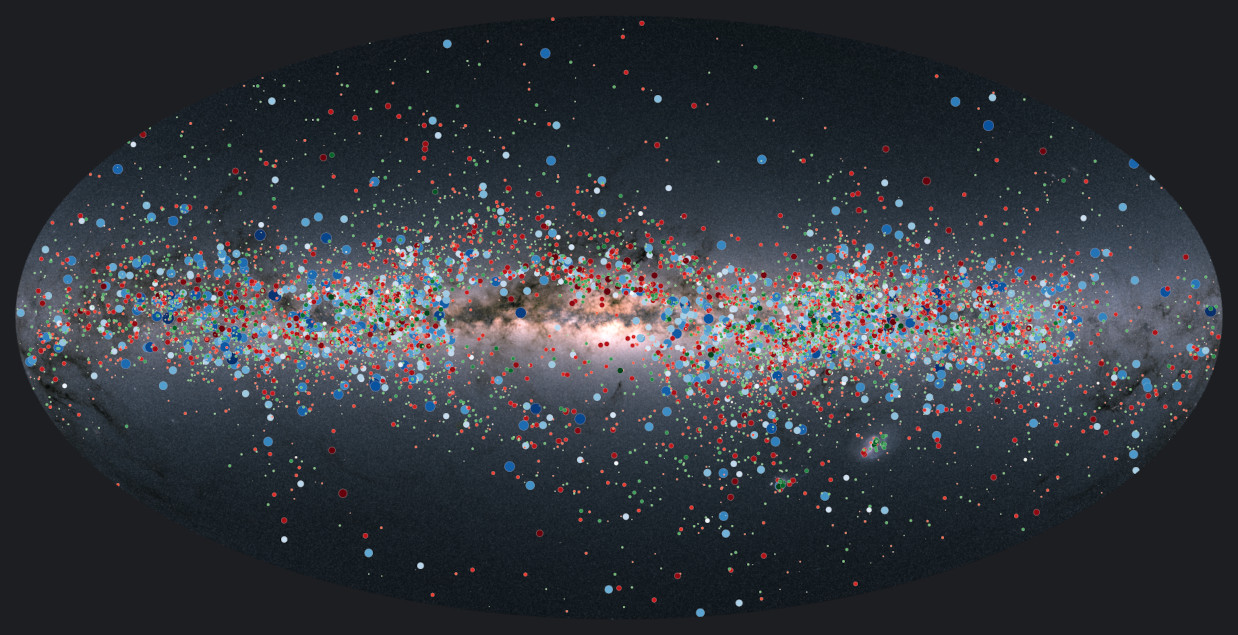Gaia Focused Product Release (Gaia FPR)
The Gaia Focused Product Release presents five data products which showcase a subset of the improvements and new data products expected for Gaia DR4. The FPR data products are based on the Gaia observations collected over the same period as used for Gaia DR3 (except for the astrometry and photometry for ω Centauri and the updated Solar System objects astrometry). These data are products based on new observation modes (astrometry and photometry from full-frame CCD images in selected crowded regions), new data processing pipelines (search for gravitationally lensed quasars, DIBs from aggregated RVS spectra), and they offer a taste of the epoch radial velocities to be publised as part of Gaia DR4.
For Solar System objects new astrometry and orbits are presented based on 5.5 years of observations (the period covered by Gaia DR4) which leads to a very significant improvement in the quality of the orbits.
Content
- Astrometry and photometry from engineering images taken in the omega Centauri region.
- The first results of quasars' environment analysis for gravitational lenses search.
- Extended radial velocity epoch data for Long Period Variables.
- Diffuse Interstellar Bands from aggregated RVS spectra.
- Updated astrometry for Solar System objects.
Overview
Skymap of the Gaia Focused Product Release Long Period Variability sample colour-coded by type and radial velocity amplitude
Image credit: ESA/Gaia/DPAC - License: CC BY-SA 3.0 IGO - Acknowledgement: created by M. Trabucchi, N. Mowlavi and T. Lebzelter
| Period of data observations | 66 months of data | 34 months of data | |
| Total number of Gaia sources | 1,812,236,358 (Gaia DR3 AGIS + Gaia FPR SIFCF) | ||
| Gaia FPR | Gaia FPR | Gaia DR3 | |
| Total number of sources | 1,811,709,771 | ||
| Number of sources with full astrometry (AGIS) | - | - | 1,467,744,818 |
| Number of sources with full astrometry (SIF Crowded Fields) | 526,457 | - | - |
| Number of sources with 2-parameter solution (AGIS) | - | - | 343,964,953 |
| Number of sources with 2-parameter solution (SIF Crowded Fields) | 130 | - | - |
| Sources with mean G magnitude (PhotPipe) | - | - | 1,806,254,432 |
| Sources with mean G magnitude (SIF Crowded Fields) | 526,587 | - | - |
| Specific Object Studies – Long-period variables | - | - | 1,720,588 |
| Long Period Variables with radial velocity time series | - | 9,614 | - |
| Photometrically-variable sources with radial-velocity time series | - | - | 1,898 |
| Sources with a diffuse interstellar band (DIB) in their RVS spectrum | - | use Gaia DR3 | 472,584 |
| Detection of diffuse interstellar bands (DIBs) in stacked spectra | - | 235,428 | - |
| List of quasar candidates used for Gravitational Lens search | - | 3,760,032 | |
| Potential gravitational lens components (including the quasars) | - | 4,760,920 | - |
| Gravitational lens candidates (which will be ranked A+ to B-) | - | 381 | - |
| Solar system objects | 156,823 | - | 158,152 |
| Solar system objects - epoch astrometry (CCD transits) | 46,264,083 | - | 23,336,467 |
| Solar system objects - orbits | 156,762 | - | 154,741 |
| Solar system objects - average BP/RP reflectance spectra | use Gaia DR3 | - | 60,518 |
| Solar system objects - planetary satellites | 31 | - | 31 |
For the full content, please refer to ESAC's documentation: Gaia FPR
Background of the data
Most data products in the Gaia Focused Product Release, e.g. 'Extended radial velocity epoch data for Long Period Variables', 'Diffuse Interstellar Bands from aggregated RVS spectra' and 'The first results of quasars environment analysis for gravitational lenses search', are based on data collected between 25 July 2014 (10:30 UTC) and 28 May 2017 (08:44 UTC) spanning a period of 34 months of data collection. This leads to a reference epoch of 2016.0, which is the same reference epoch as applicable to Gaia EDR3 and Gaia DR3.
The 'Updated astrometry for Solar System objects' in Gaia's focused Product Release are based on data collected from 26 July 2014 to 20 January 2020, spanning a period of 66 months of data collection.
The 'Astrometry and photometry from engineering images taken in the Omega Centauri region' are based on data collected since 1 January 2015.
Remember that the reference epoch is different for each Gaia data release, and that the reference epoch for Gaia DR2 was J2015.5 (based on 22 months of data) and for Gaia DR1 was J2015.0 (based on 14 months of data).
Positions and proper motions are referred to the ICRS, to which the optical reference frame defined by Gaia DR3 (Gaia-CRF3) is aligned. The time coordinate for Gaia FPR results is the barycentric coordinate time (TCB).
